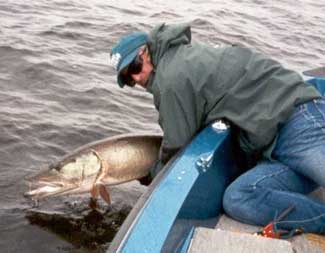 Most people call it the “walleye opener.” But to a die-hard muskie angler, it’s just the beginning of the preseason. Depending on where you fish, there are a few weeks between the walleye opener and what I call the “real” opener. Use these weeks to get ready for the real deal.
Most people call it the “walleye opener.” But to a die-hard muskie angler, it’s just the beginning of the preseason. Depending on where you fish, there are a few weeks between the walleye opener and what I call the “real” opener. Use these weeks to get ready for the real deal.
We had all winter to take care of tackle maintenance, lure modification and reconditioning, and planning and research. For the past few weeks, we’ve been respooling the reels, prepping the boat and motor, and maybe even getting into some crappies, trout, or river fish.
But now it’s time to get out on the lakes that have actual warm-water game fish. Now it’s time to tune up your game.
There are a lot of things you can accomplish in spring training. You can get in shape. You can test your tackle. And you can even learn new water and check out new spots. At this point, I need to make one thing perfectly clear: I am NOT talking about harassing or harming pre-season muskies. If I even see a muskie, whether I see a shallow spawner or get a follow, I immediately leave the area.
One thing you can do starting on opening day is fish for the muskie’s esox cousin, the northern pike. (I like to do this on lakes that don’t have muskies.) You can get the casting muscles warmed-up, and then built-up for muskie fishing. Muskie fishing can be physically abusive, especially if you come out cold and hit it hard. Hardcore muskie fishing, especially those 10-, 12-, even 16-hour days, can grind you down. Use pike fishing, which usually involves slightly smaller lures and lighter rods, to prepare your body for muskie season.
You can also work the kinks out of your tackle during spring training. That is why I like lakes without muskies-so I can use muskie tackle with no ethical problems. Have you had a few muskie reels repaired over the winter? Why not check them out on pike? Make sure the casting brakes do their job. Make sure the gears don’t grind. Make sure the drag slips smoothly. Do it now-on pike. If everything works fine, that’s great. If a reel fails, maybe you’ll have time to get it fixed. You don’t want any surprises next month when that first 50-incher nails your bait.
 You can also test your lure modifications on pike. Did you tie some bucktails over the winter? Did you add weight to some jerkbaits? Find out whether the spinner blades spin, find out if the newly weighted jerkbait is neutrally buoyant as you had hoped. If you’re like me, you might also have “invented” some lure concoctions over the winter. Find out how they work-now, in the preseason, when there are no muskie anglers around to laugh at your not-so-impressive inventions. (Maybe you don’t have this problem… maybe it’s just me.)
You can also test your lure modifications on pike. Did you tie some bucktails over the winter? Did you add weight to some jerkbaits? Find out whether the spinner blades spin, find out if the newly weighted jerkbait is neutrally buoyant as you had hoped. If you’re like me, you might also have “invented” some lure concoctions over the winter. Find out how they work-now, in the preseason, when there are no muskie anglers around to laugh at your not-so-impressive inventions. (Maybe you don’t have this problem… maybe it’s just me.)
In addition to tuning yourself up and checking out your tackle, the other thing I mentioned is learning new water and checking out new spots. By necessity, this is done on muskie water, and best done when bass are in season. To do this, I put away the pike tackle and switch to a 7-foot spinning rod, rigged with 6-pound mono and a shallow-running crankbait.
On the lakes I fish, early season smallmouth bass are consistently found on boulder points, weed/rock reefs, and bays with rock piles… you may already see where this is going. Early season smallies are “borrowing” spots that will be taken over by muskies in a few weeks. Maybe there is a spring bass/summer muskie connection on your lake too. Maybe on your lake, it’s also spring smallmouth rocks = summer muskie rocks. Or maybe on your lake, it’s spring largemouth weeds = summer muskie weeds. On lakes like Minnetonka that have a healthy population of both largemouth and smallmouth, maybe both patterns exist.
Whatever the connection on your lake, you can use the preseason to scout out spots. You can run-and-gun for bass, learning new potential spots in the process. You can slow down to learn old spots better. You can study spots that produced muskies last year by methodically working the bass with light or ultralight bass tackle. The water is as clear as it’s going to get, so you can see and study the details of your summer muskie spots. You can learn the water and enjoy the bass at the same time.
And if a muskie shows up, you can get the heck out of there! Make a note of it, obviously, but get out of there. And don’t come back until the real opener. Don’t mess with ANY pre-season or spawning muskies. For every large female muskie that gets disturbed, hundreds of thousands of muskie eggs are put at risk. The odds stink as it is, so let’s not make them any worse.
It’s spring training. Scores and standings don’t count. So have fun with the pike and the bass-and, in the process, prepare yourself for the real deal.
Catch a nice one and let it go. Let them ALL go.










